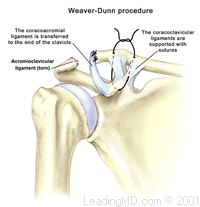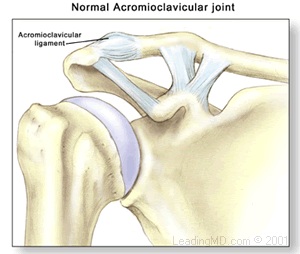 Overview
Overview
An acromioclavicular joint separation, or AC separation, is a very frequent injury among physically active people. In this injury the clavicle (collar bone) separates from the scapula (shoulder blade). It is commonly caused by a fall directly on the "point" of the shoulder or a direct blow received in a contact sport. Football players and cyclists who fall over the handlebars are often subject to AC separations.
In general, most AC injuries don't require surgery. There are certain situations, however, in which surgery may be necessary. Most patients recover with full function of the shoulder. The period of disability and discomfort ranges from a few days to 12 weeks depending on the severity of the separation. Disruption of the AC joint results in pain and instability in the entire shoulder and arm. The pain is most severe when the patient attempts overhead movements or tries to sleep on the affected side.
What does the inside of the shoulder look like?
The shoulder is the most mobile joint in the human body, with a complex arrangement of structures working together to provide the movement necessary for daily life. Unfortunately, this great mobility comes at the expense of stability. Several bones and a network of soft tissue structures (ligaments, tendons, and muscles), work together to produce shoulder movement. They interact to keep the joint in place while it moves through extreme ranges of motion. Each of these structures makes an important contribution to shoulder movement and stability. Certain work or sports activities can put great demands upon the shoulder, and injury can occur when the limits of movement are exceeded and/or the individual structures are overloaded.Click here to read more about shoulder structure. What is an AC joint separation? An AC joint separation, often called a shoulder separation, is a dislocation of the clavicle from the acromion. This injury is usually caused by a blow to the shoulder, or a fall in which the individual lands directly on the shoulder or an outstretched arm. AC joint separations are most common in contact sports, such as football and hockey.
The severity of an acromioclavicular joint injury depends on which supporting structures are damaged, and the extent of that damage. Tearing of the acromioclavicular ligament alone is not a serious injury, but when the coracoclavicular ligaments are ruptured, the whole shoulder unit is involved, thus complicating the dislocation.
Simple AC injuries are classified in three grades ranging from a mild dislocation to a complete separation:
| rade I - A slight displacement of the joint. The acromioclavicular ligament may be stretched or partially torn. This is the most common type of injury to the AC joint. | 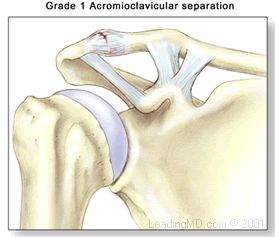 |
| Grade II - A partial dislocation of the joint in which there may be some displacement that may not be obvious during a physical examination. The acromioclavicular ligament is completely torn, while the coracoclavicular ligaments remain intact. | 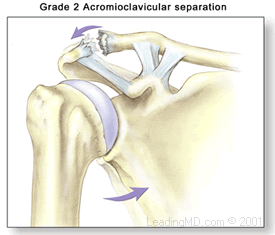 |
| Grade III - A complete separation of the joint. The acromioclavicular ligament, the coracoclavicular ligaments, and the capsule surrounding the joint are torn. Usually, the displacement is obvious on clinical exam. Without any ligament support, the shoulder falls under the weight of the arm and the clavicle is pushed up, causing a bump on the shoulder. | 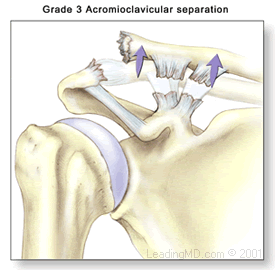 |
There are a total of six grades of severity of AC separations. Grades I-III are the most common. Grades IV-VI are very uncommon and are usually the result of a very high-energy injury such as one that might occur in a motor vehicle accident. Grades IV-VI are all treated surgically because of the severe disruption of all the ligamentous support for the arm and shoulder.
SYMPTOMS
What are the signs and symptoms of an AC joint separation?
Grade I Injury:
|
 |
Grade II Injury:
|
 |
Grade III Injury:
|
 |
DIAGNOSIS
After evaluating the history of the patient's injury the doctor will examine the shoulder area looking for signs of fracture or dislocation by comparing the overall position of the arm and shoulder to the uninjured side. The AC joint itself is easily examined because it is located right under the skin. The doctor will gently feel the bones and soft tissue around the joint and between the acromion and clavicle. There may be a bump, tenderness or instability, which would suggest a joint separation. Crepitus (noise) as the bones move may indicate a fracture. The doctor also evaluates the patient's range of motion and performs tests to isolate specific areas of pain and weakness.
Further evaluation may include:
- A diagnostic anesthetic injection, which blocks pain, can help confirm the diagnosis.
- X-rays can confirm a diagnosis of an AC joint separation and can help the physician determine whether the injury is a separation or a fracture. A new cross body X-ray has been recently developed which is very helpful in confirming the diagnosis and may be in general use in the near future
RECOVERY
Patients with lower energy AC joint injuries that respond to conservative non-operative treatment can recover in as little as one week for a Grade I injury to an average of twelve weeks for a Grade III injury.
Operative
Specific recovery programs following surgical reconstruction of the AC joint vary depending on the type of surgery performed. General care recommendations include:
- The use of a sling is required for about 4 weeks.
- Incisions must be kept dry for about three days after surgery.
- Stitches are usually removed 7 - 10 days after surgery.
- Lower arm exercises may begin immediately. With an open surgical technique the arm may be immobilized for 2-3 weeks before motion exercises are begun.
- No lifting for 3 weeks.
- Overhead motion is limited for the first 8-12 weeks because the fixation of the clavicle to the coracoid process prevents the normal rotation necessary for overhead movements.
- The patient is allowed use of the arm at waist height to write or perform computer work for the first 12 weeks. After that time, the screw (if used) is removed, or the sutures have softened enough to begin more aggressive range of motion and strengthening exercises.
- After the removal of the sling, 6-8 weeks of physical therapy is necessary to regain full motion.
- Strength and velocity motions of the throwing athlete may be delayed for 4-6 months.
FAQs
Do all AC separations require surgery?
No. In fact the vast majority of AC separations do very well with conservative treatment of the symptoms. Most AC injuries are grade I, II, or III and these generally do not require surgery. Usually the joint remains sore for two to six weeks and then full return to activity is the norm. Only unstable grade III injuries and high-energy AC separations, which are often the result of motor vehicle accidents, require surgery for full recovery.
Will the "bump" ever go away?
The clavicle will become stable in its newly elevated position, but without surgery the "bump" will remain. The joint will function normally and will not remain tender to touch or movement. This minor cosmetic deformity will persist but will not interfere with overhead activities or participation in sports.
Are there downsides to a resection of the AC joint?
An AC resection is a procedure in which the end of the clavicle is removed and the acromioclavicular ligament in reattached into the end of the clavicle to replace the ligament torn during injury. Once the initial injury has healed and the clavicle has regained stability from scar tissue there is no functional loss with an AC resection. In the rare instance that the AC joint remains painful after a separation, but does not require stabilization, an AC resection is very effective in relieving pain without sacrificing function. If, however, the clavicle is unstable at the time of resection, a full reconstruction of the coracoclavicular ligaments is necessary to maintain the stability of the upper extremity. Will I be able to return to athletics if an AC injury is not treated? Absolutely. Most athletes in contact sports have had a low energy AC separation at some time in their careers. Except for the slight deformity that remains, there is no clinical significance to a healed AC separation. Occasionally high-energy AC separations that have disruption of the AC and CC ligaments will require surgery, but these injuries are usually apparent early on with a correct X-ray evaluation. Grade I, II, and most grade III AC separations will heal without treatment and a full return to sports can be expected.
